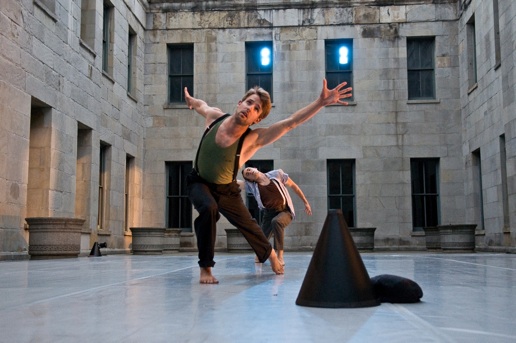
Converting currency to gold
The word ecology is derived from the Greek oikos, or house. And in this sense, and perhaps its very best sense, the work of Joe Goode is ecological. His dance-based performances examine the house in which we live and how we live in it, rather than the body and its strengths or how it struggles against gravity and its surrounding forces.
Last week the Joe Goode Performance Group performed ‘Traveling Light’ at the San Francisco Mint, allowing its audiences to experience its profound poetic beauty. The work premiered last August, but it should become a recurring part of the mint’s restoration as a museum, so valuable is its artistic worth as a part of San Francisco’ cultural milieu.
The old Mint was built in 1874 and once housed a third of the nation’s gold supply, using massively wheeled presses to stamp the coins that were our currency. Although it stopped making coins in 1937, its structure remains grand and imposing, a sort of elegant fortress with lighting fixtures that would put the de Medici family to shame.
Goode had been searching for a site for his next collaboration with production and lighting designer, Jack Carpenter, when they came across the old mint with its tall ceilings, long corridors, effusive balconies, massive pillars, and huge open courtyard surrounded on four-sides by the gray stone, multi-windowed building. They saw it as the perfect canvas for light and shadow and Goode’s own form of athletic dance and textual musings.
Goode came back to visit each room, gathering the imagery that the rooms conjured up in him and weaving them into a series of vignettes that suggest a narrative even as they disappear into fragmentary gestures. In one room in which a double line of pillars frames the walk from door to door, he saw four faces close together, a bright light shining on their upturned gaze.
The viewer traveling lightly
The final piece is methodically and precisely tracked. Four groups of audience move through the half a dozen rooms, each following a different path and experiencing the piece as a different though sonically overlapping series.
The audience is first led to the basement of the mint, a brick-walled subterranean warren with a central corridor off of which lie small rooms. In one, dollar bills float in the air; in another, a woman lounges in a bathtub, turbaned like the painter David’s dead Marat. Two rag-covered beggars huddle over a small grill, warming their hands, while vocalizing in harmony. The effect is eerie, like the basement of Madame Tussaud’s wax-work museum; though the images border on the worn, they set the premise for the piece and become the subconscious for the more complex performance that begins in the light and florid rooms of the upper floors.
My journey through ‘Traveling Light’ began in a large open room where a young dancer began a long lament: “This is not a good time. This is a nothing time, a dull, grayish, drab time.” It’s clear he’s talking about the economy. He’s looking for a job, he’s trying, nothing works out. Groups of two and three dancers wind through, their movements electric and athletic. Orange lights beaming up from the floor throw their shadows on the wall. Two of the male dancers pick up one of the women and throw her up, holding her against the wall, as if she were splashed onto its surface like a pail of water. The moment is gorgeously beautiful.
Likewise, the production had many moments that were startlingly imaginative: the hugely bustled Victorian dress that moved on casters, giving the dancer’s movement a preternatural smoothness; the huge lighting crane along which a spotlight moved in midst of faux classical columns; cabbages dropping from a dancer’s arms.
The old Mint is a house that money built, and lucky for us, it was here that Joe Goode and Jack Carpenter’s collective imagination was enthralled. For the Mint radiates mystery and myth: its walls speak of all the blessings and disasters of wealth and its evil twin, poverty. Is this house the inevitable ecology of capitalism? ‘Traveling Light’ poses the question.
—Jaime Robles
